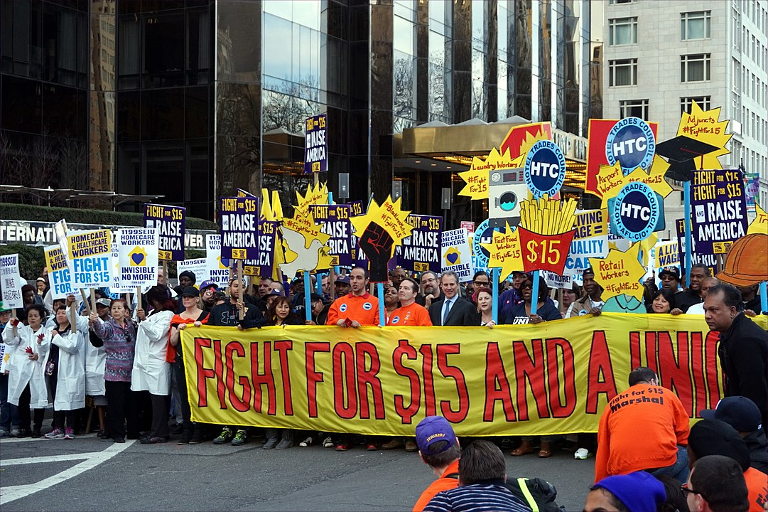News that the prices of some essential food items, from pasta to rice to vegetable oil, have risen by as much as 50% in the last year is a stark reminder that the cost of living crisis is about far more than just the price of home energy – crucial as that is.
Protecting standards of living will require more than just one-off payments from the chancellor of the exchequer. It will need a fundamental shift in how our economy operates, back towards prioritising the earnings of those who work. With the OECD this morning forecasting that, next year, the UK faces the lowest growth of any major developed economy, economic growth alone is unlikely to deliver here.
Our research, published by the Progressive Economy Forum, shows that a £15 an hour minimum wage is a fast and effective way to do this – benefiting the lowest paid the most, restoring pay after a ‘lost decade’ of near-zero pay growth, and protecting workers against inflation.
The National Living Wage, the minimum that all employees over 22 are legally obliged to receive, is set to hit £10.50 in 2024. It has been increasing more rapidly than average earnings in recent years, but with inflation now pushing 9% – and expected to rise even higher at the end of this year – the 6.6% increase to £9.50 in April left low-paid workers’ pay lagging well behind price rises.
It’s worth remembering that inflation is cumulative – prices aren’t going to start falling by as much as they rose. If prices are rising by 9% now, that is a permanent loss in purchasing power for people’s wages, even if inflation eventually comes back down to the Bank of England’s 2% target. Any losses from high inflation today will be for good, unless wages increase by at least as much.
And as the Resolution Foundation has shown, because lower-income households have to spend proportionately more of their earnings on essentials – things like food and heating – they are disproportionately affected by price rises in those essentials. But these are exactly the items that have been rising the most in price, meaning the true rate of inflation for the poorest 10% of households is estimated to be as much as 14%. This is a disastrous loss of purchasing power for the poorest.
This inflation bombshell lands on top of workers who have already endured an unprecedented ‘lost decade’, with wages and salaries in real terms (that is, after allowing for price rises) scarcely higher in 2019 than they were in 2008. Those real wages are now falling at the fastest rate perhaps since the catastrophic ‘Engels Pause’ of the Industrial Revolution, nearly 200 years ago.
It is a little ridiculous, under these circumstances, to argue (as central bankers and others have done) that the country risks a wage-price spiral. Far from high wages leading to high prices, as people argue they did in the 1970s, we are clearly now suffering from wages and salaries being far too low, whilst price rises are driven by events in the rest of the world. Pay ‘restraint’ by shopworkers or nurses in Britain will not end Russia’s invasion of Ukraine, or bring down the price of gas in Qatar. We are also, sadly, a long way from having 1970s-style trade unions that can protect workers’ pay.
Instead of focusing on wages and salaries as the problem, we suggest they are part of the solution. Because even as pay has fallen behind in real terms, profits – especially for those companies monopolising essentials, like natural gas and oil – have shot up to record levels. We should be looking to squeeze profits, not pay, if we want to deal with inflation.
That is exactly what a £15 an hour minimum wage does. Our modelling shows that is what the National Living Wage would be in 2024, if average pay had risen at the same rate after 2008 as it did before, and inflation was accounted for. In other words, it compensates for the ‘lost decade’ of earnings.
And it means that the share of the whole economy going to employees – their share of the ‘pie’ – would be back at the same level it was in the 2000s, before the 2008 crash and subsequent austerity. It means that the poorest 70% of households would see a 7% increase in their earnings, with the poorest 10% receiving far more. Fourteen million people, in total, would benefit from at least some pay rise, ending the scourge of poverty pay in Britain.
And it is affordable. We know large companies have fat profits to rely on, but smaller businesses have been squeezed. By taking the extra revenues earned by the government, from higher taxes paid by better-off employees, and from the savings on Universal Credit as poverty pay is wiped out, we have enough money to compensate smaller businesses for their expected increased labour costs – even after taking account of the government needing to pay more to its own employees.
The cost-of-living crisis is likely to worsen from this point on. None of the ‘solutions’ offered by the government and the Bank of England have so far matched up to it. It’s time for some bold thinking on how to fairly protect those in work from the worst of its impact. A £15 an hour minimum wage by 2024 should be the target.
Teaser photo credit: By The All-Nite Images from NY, NY, USA – Fight for $15 on 4/15, CC BY-SA 2.0, https://commons.wikimedia.org/w/index.php?curid=44970719





